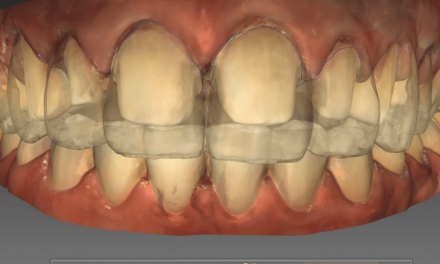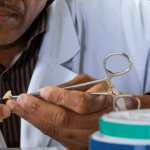INTERVIEW WITH LINO ADOLF
Going digital is not the future, it’s the present.

Lino Adolf, Dental Techician, Ely UK
20 July 2018
Lino Adolf is a dental technician based in Ely, UK. He has been a user of the Dentpsly Sirona InLab system since 2009, and is a certified InLab trainer and founder of the Academy of Digital Dentistry. Here he explains how using digital technology has transformed his working life, and why for him going digital is a no-brainer
Born and raised in South Africa, Lino Adolf trained in dental technology in Portugal, before moving to the UK in 2006 and setting up his own lab, Majestic Smile in Ely, near Cambridge. It’s a small, digital based dental laboratory, with just two technicians and their highly specialist equipment. ‘I chose to remain a small, digital lab, focusing on high quality work,’ explains Lino. He invested in the Dentsply Sirona InLab system in 2009.
Lino decided to go for the entire portfolio: scanner, software and milling unit, from Dentsply Sirona. He had experience of working with CAI/CAD/CAM in training and in previous jobs, and knew that this was the way he wanted to go.
‘I chose the InLab system for three main reasons,’ he says. ‘Firstly, I wanted everything under one umbrella – from the same manufacturer so that there was only one supplier to deal with. Secondly, I elected to work with the market leader, a major company with an excellent reputation, and thirdly I liked the diversity of materials that this system allowed me to work with. This range of materials is even wider now, and it gives me more choice and better service to my dentist clients.’
What Lino appreciates most about the system is the time factor. Most of the dentists he works with are Cerec dentists, and the communication between them is very simple, though he can also work with dentists using other systems. The dentist sends the scan to him via the Sirona Connect Portal, completely securely, and he receives it instantly. If he has any questions or problems with the information, the patient is still in the chair and a scan can be re-taken or extra information gathered immediately if necessary.
‘With digital impressions I can visualise the impression instantly and start work at once,’ he says. ‘With a straightforward crown I can receive the file, download the information and start the whole process within 5-6 minutes.’ The system also allows him to provide design services very rapidly, and work can be carried out much faster than using conventional impressions and techniques.
Location doesn’t matter either. Lino recently worked with a dentist in Portugal, who needed a crown prepared and ready to fit in just two days. The file was sent to him on Wednesday morning, and the crown was ready in Portugal on the Friday. ‘I could have done the work for a dentist abroad by conventional methods,’ says Lino, ‘but I could never have done it in the time.’ An average case would normally take him approximately 5-7 working days to turn around.
He also loves the accuracy and predictability of digital technology. ‘If you receive analogue impressions there is always a risk of error in manipulation, air bubbles, dragging and other discrepancies. Digital scans are always 100% accurate and they provide total consistency,’ he says. ‘I can repeat a crown 50 times and it will always be identical. Using conventional methods you can’t be sure it’s exactly the same even twice!’ In addition to the scans, the dentist can upload photos and as much additional information as they choose so that the technician can do the work accordingly.
The technology won’t de-skill the technician. ‘You still need your knowledge and expertise,’ he says. ‘It is simply a tool to enable you to do your work better. Instead of waxing and carving by hand you are doing it on the screen, and it’s a new technique to learn. But it’s like replacing your old pen with a fantastic electronic one – you still need to know how to write.’
Education in using the system is crucial, and this needs to be ongoing, says Lino. Initial training is mandatory and provided by Sirona, then further training is provided, allowing the user to hone their skill in using the equipment. Importantly, the ongoing education is provided not by representatives of the company but by certified InLab trainers, real technicians expert in using the equipment in their daily work. Lino is one of them. ‘Being a certified trainer allows me to share my knowhow and expertise with users, showing them how to leverage their software and design techniques, and get the most out of their equipment as they take on more complex cases.’
Lino believes making the switch to digital is a mindset. ‘I took a calculated risk when investing in the technology at an early stage,’ he says. ‘The market today is digital and will keep going that way. You need to embrace it now and be going with the curve. Delaying it will make you too late and you will just be a follower, and it will be much harder to establish a reputation as a digital lab.’
In his own view, going digital provides Lino with:
- Accuracy
- Time
- Predictability
- Reassurance – he deals with just one company, the market leader with an unparalleled reputation.
‘Time is money,’ says Lino. ‘Digital technology allows the lab to be more productive and more efficient, saving you money and making you money.’ He adds: ‘My time is precious. Using the technology means that I spend less time at the bench because the equipment is doing the work. That frees me up to choose how I wish to spend that time – generating new business, going for more complex and specialist work – or whatever I wish.’
‘Digital dentistry is not the future – it’s the present, and you need to embrace it or risk being left behind.’
Case Studies:
1.Sirona Connect – 48HR Central
This case was sent to me via CEREC Connect by Dr Paulo Monteiro (DentalFafe), who practices in Portugal. The patient came in showing a very poor restoration and complaining about the dark tooth coloration in the cervical area of the upper right central, which was an endodontically treated tooth. The dentist requested a metal free restoration. Due to the dark stump and the edge-to- edge position of that tooth, I decided to go with a multilayer design restoration.
The dentist did some internal bleaching to reduce that discolouration as much as possible. The inCoris Zi framework allowed me to hide the darkness of the stump and e.max CAD for the veneering structure. Using the reduction tool, I did a partial reduction of the veneering structure to allow some porcelain application.
CEREC Connect and the inLab system have allowed me to reduce significantly the turn around time of the restorations, without any compromise to the quality.
1 – Prep for the desired restoration. Important to manage so tissue prior to taking the optical impression.

4- Multilayer – Using inLab SW it allows to create a multilayer restoration with one click. We have a framework which will be milled in Zi and a veneering structure which will be milled in a lithium based material.
2. Cantilever Bridge
Cantilever bridge required an extraction of the lateral. Bridge designed using inLab SW milled on the MCX5 using Cercon HT zirconia and minimal cutback on the incisal third and layered using Celtra Ceram. Some pink porcelain was added on the cervical of the lateral.
3. Modeless Screw Retained Implant Crown
Sirona Connect implant case. One of the great benefits of working with a digital dentist is that communication improves tremendously allowing us to do cases like this one without a model. Not having to print a model allows me to turn around cases such as this quicker if required.
4. Two Single Centrals
Digital impression of the preparations obtained using the CEREC Omnicam AC. Sent to the lab using the Sirona Connect portal. Once the lab receives the impressions, places an order for a digital model, in this case infiniDent model was ordered or prints one in house.
5. All On 6
This case was done with a Dental Practice in Azores. Full upper and lower implant case on 6 implants – All on 6 – a pre-setup was made using denture acrylic teeth as a mockup done by João Santos Silva (in-house dental technician in Azores), to assess function and aesthetics.
Once those were approved by the clinician and the patient we proceed with the final restoration. Using inLab system we designed upper and lower implant frameworks, milled out frameworks from PEEK and subsequent single units from lithium based material.
Using a digital workflow allowed us to do this case from start to finish in 2 days.
Conclusion
Digital impression-taking in combination with Sirona Connect is an innovative process that delivers optimum precision. In many cases the dentist can dispense with a conventional impression tray and compound, without having to modify his or her accustomed practice workflow. Instead, the dentist simply acquires and transmits digital impressions to the lab.
The conventional impression and subsequent model production is labour intensive and an error prone process in dental practices and laboratories. The optical digital impression facilitates precision and minimises possible sources of error, the most common impression error sources such as bubbles, blood and saliva – contamination and loss of precision, torn material during impression withdrawal, impression changes – time between taking the impression and model being made, amongst others compromises the quality of the dental protheses.
Using the Sirona Connect Portal, there’s a direct connection between the practice and the laboratory with fast data transfer. We are therefore able to provide simultaneous feedback as long as the patient is still in the practice, any changes can be done on the spot without having to reschedule the patient. This is highly beneficial for everyone involved in comparison to conventional methods.





































